Overprinting Mineralization in the Huoluotai Porphyry Cu (Mo) Deposit, NE China: Evidence from K-Feldspar Ar-Ar Geochronology and S-Pb Isotopes
Abstract
1. Introduction
2. Regional Geology
3. Ore Deposit Geology
4. Sampling and Analytical Methods
4.1. Sampling
4.2. Analytical Methods
4.2.1. K-Feldspar 40Ar/39Ar Geochronology
4.2.2. Sulfur Isotope Analyses
4.2.3. Pb Isotope Analyses
5. Results
5.1. 40Ar/39Ar Age of Hydrothermal K-Feldspar
5.2. Sulfur Isotopes
5.3. Pb Isotopes
6. Discussion
6.1. Two Mineralization Events in the Huoluotai Cu(Mo) Deposit
6.2. Origin of Ore-Forming Metals
6.3. Late Early Cretaceous Tectonic Setting and Mineralization Events
7. Conclusions
- (1)
- Two mineralization events were identified in the Huoluotai deposit: (a) the early porphyry-type Cu (Mo) mineralization with the potassic alteration zone and the phyllic alteration zone from the center to the margin, and (b) the late vein-type Cu mineralization.
- (2)
- Our results, combined with previous molybdenite Re-Os and zircon U-Pb age data, reveal that mineralization in the Huoluotai deposit comprises two magmatic-hydrothermal events. The porphyry Cu (Mo) mineralization was formed in the late Late Jurassic and was spatially–temporally associated with the granodiorite porphyry (148.9 ± 0.9 Ma), while the vein-type Cu mineralization occurred in the Early Cretaceous (about 122 Ma) and was associated with the quartz diorite porphyry.
- (3)
- Sulfide S-Pb isotope compositions of the two mineralization events suggest that both have a magmatic source. The origin of ore-forming metals displays the features of a crust–mantle mixing origin.
- (4)
- Late Early Cretaceous mineralization events (133~106 Ma) in the GXR were formed under an extensional setting, which were associated with large-scale lithosphere delamination and the upwelling of the asthenospheric mantle triggered by the rollback of the Paleo-Pacific Plate.
Supplementary Materials
Author Contributions
Funding
Data Availability Statement
Conflicts of Interest
References
- Sillitoe, R.H. Porphyry copper systems. Econ. Geol. 2010, 105, 3–41. [Google Scholar] [CrossRef]
- Catchpole, H.; Kouzmanov, K.; Putlitz, B.; Seo, J.H.; Fontboté, L. Zoned base metal mineralization in a porphyry system: Origin and evolution of mineralizing fluids in the Morococha district. Peru. Econ. Geol. 2015, 110, 39–71. [Google Scholar] [CrossRef]
- Heinrich, C.A. The physical and chemical evolution of low-salinity magmatic fluids at the porphyry to epithermal transition: A thermodynamic study. Miner. Deposita 2005, 39, 864–889. [Google Scholar] [CrossRef]
- Sun, Y.G.; Li, B.; Sun, F.Y.; Ding, Q.F.; Wang, B.Y.; Li, Y.J.; Wang, K. Mineralization events in the Xiaokele porphyry Cu (–Mo) deposit, NE China: Evidence from zircon U–Pb and K-feldspar Ar–Ar geochronology and petrochemistry. Resour. Geol. 2020, 70, 254–272. [Google Scholar] [CrossRef]
- Von Quadt, A.; Erni, M.; Martinek, K.; Moll, M.; Peytcheva, I.; Heinrich, C.A. Zircon crystallization and the lifetimes of ore-forming magmatic-hydrothermal systems. Geology 2001, 39, 731–734. [Google Scholar] [CrossRef]
- Chiaradia, M.; Schaltegger, U.; Spikings, R.; Wotzlaw, J.F.; Ovtcharova, M. How accurately can we date the duration of magmatic-hydrothermal events in porphyry systems?—An invited paper. Econ. Geol. 2013, 108, 565–584. [Google Scholar] [CrossRef]
- Deckart, K.; Clark, A.H.; Aguilar, A.C.; Vargas, R.R.; Bertens, A.N.; Mortensen, J.K.; Fanning, M. Magmatic and hydrothermal chronology of the giant Río Blanco porphyry copper deposit, central Chile: Implications of an integrated U-Pb and 40Ar/39Ar database. Econ. Geol. 2005, 100, 905–934. [Google Scholar] [CrossRef]
- Windley, B.F.; Alexeiev, D.; Xiao, W.J.; Kröner, A.; Badarch, B. Tectonic model for accretion of the Central Asian Orogenic Belt. J. Geol. Soc. London. 2007, 164, 31–47. [Google Scholar] [CrossRef]
- Wang, L. Huoluotai, Mohe Country, Heilongjiang Province Study on Geological Characteristics and Prospecting Direction of Copper Molybdenum Deposit Summary. Master’s Thesis, Jilin University, Changchun, China, 2018. (In Chinese with English abstract). [Google Scholar]
- Deng, C.Z.; Li, G.H. The Cu-Mo mineralization of the Late Jurassic porphyry in the Northern Great Xing’an Range: Constraints from zircon U-Pb ages of the Ore-Causative Granites. Acta Geol. Sin. 2019, 93, 236–237. [Google Scholar] [CrossRef]
- Sun, Y.G.; Li, B.L.; Zhao, Z.H.; Sun, F.Y.; Ding, Q.F.; Chen, X.S.; Li, J.B.; Qian, Y.; Li, Y.J. Age and petrogenesis of late Mesozoic intrusions in the Huoluotai porphyry Cu-(Mo) deposit, northeast China: Implications for regional tectonic evolution. Geosci. Front. 2022, 13, 101344. [Google Scholar] [CrossRef]
- Sun, Y.G.; Li, B.L.; Sun, F.Y.; Qian, Y.; Yu, R.T.; Zhao, T.F.; Dong, J.L. Ore Genesis of the Chuduoqu Pb-Zn-Cu Deposit in the Tuotuohe Area, Central Tibet: Evidence from Fluid Inclusions and C–H–O–S–Pb Isotopes Systematics. Minerals 2019, 9, 285. [Google Scholar] [CrossRef]
- Sun, Y.G.; Li, B.L.; Ding, Q.F.; Qu, Y.; Wang, C.K.; Wang, L.L.; Xu, Q.L. Mineralization Age and Hydrothermal Evolution of the Fukeshan Cu (Mo) Deposit in the Northern Great Xing’an Range, Northeast China: Evidence from Fluid Inclusions, H–O–S–Pb Isotopes, and Re–Os Geochronology. Minerals 2020, 10, 591. [Google Scholar] [CrossRef]
- Sun, Y.G.; Li, B.L.; Ding, Q.F.; Meng, F.B.; Chen, X.S.; Qian, Y.; Wang, L.; Wang, L.L.; Xu, Q.L. Timing and ore formation of the Xiaokele porphyry Cu (–Mo) deposit in the northern Great Xing’an Range, NE China: Constraints from geochronology, fluid inclusions, and H–O–S–Pb isotopes. Ore Geol. Rev. 2022, 143, 104806. [Google Scholar] [CrossRef]
- Sun, Y.G.; Li, B.L.; Chen, X.S.; Meng, F.B.; Ding, Q.F.; Qian, Y.; Wang, L.L. Fluid inclusions and C–H–O–S–Pb isotopes of the Huoluotai porphyry Cu (Mo) deposit in the northern Great Xing’an Range, NE China: Implication for ore genesis. Minerals 2022, 12, 1072. [Google Scholar] [CrossRef]
- Zhao, Z.H.; Zhao, X.; Yin, Y.C.; Liang, S.S.; Chen, J.; Li, C.L.; Zhou, J.Z. Genesis of the Yidonglinchang gold deposit, Lesser Xing’an Range, China: Insights from fluid inclusions, H-O-S-Pb isotopes, and Sm-Nd and U-Pb geochronology. Ore Geol. Rev. 2023, 163, 105803. [Google Scholar] [CrossRef]
- Deng, C.Z.; Sun, D.Y.; Han, J.S.; Chen, H.Y.; Li, G.H.; Xiao, B.; Li, R.C.; Feng, Y.Z.; Li, C.L.; Lu, S. Late-stage southwards subduction of the Mongol–Okhotsk oceanic slab and implications for porphyry Cu–Mo mineralization: Constraints from igneous rocks associated with the Fukeshan deposit, NE China. Lithos 2019, 326, 341–357. [Google Scholar] [CrossRef]
- Wu, F.Y.; Sun, D.Y.; Ge, W.C.; Zhang, Y.B.; Grant, M.L.; Wilde, S.A.; Jahn, B.M. Geochronology of the Phanerozoic granitoids in northeastern China. J. Asian Earth Sci. 2011, 41, 1–30. [Google Scholar] [CrossRef]
- Zhou, J.B.; Wilde, S.A.; Zhao, G.C.; Han, J. Nature and assembly of microcontinental blocks within the Paleo-Asian Ocean. Earth-Sci. Rev. 2018, 186, 76–93. [Google Scholar] [CrossRef]
- Xu, W.L.; Pei, F.P.; Wang, F.; Meng, E.; Ji, W.Q.; Yang, D.B.; Wang, W. Spatial–temporal relationships of Mesozoic volcanic rocks in NE China: Constraints on tectonic overprinting and transformations between multiple tectonic systems. J. Asian Earth Sci. 2013, 74, 167–193. [Google Scholar] [CrossRef]
- Liu, Y.J.; Li, W.M.; Feng, Z.Q.; Wen, Q.B.; Neubauer, F.; Liang, C.Y. A review of the Paleozoic tectonic in the eastern part of Central Asian Orogenic Belt. Gondwana Res. 2017, 43, 123–148. [Google Scholar] [CrossRef]
- Jing, Y.; Ge, W.C.; Yang, H.; Dong, Y.; Zhang, Y.L.; Ji, Z. The Early Paleozoic granites in the Mohe region of northern Great Xing’an Range: Response to post-collision extension of the Erguna-Xing’an blocks. Acta Petrol. Sin. 2022, 38, 2397–2418. [Google Scholar]
- Miao, L.C.; Liu, D.Y.; Zhang, F.Q.; Fan, W.M.; Shi, Y.R.; Xie, H.Q. Zircon SHRIMP U-Pb ages of the “Xinghuadukou Group” in Hanjiayuanzi and Xinlin areas and the “Zhalantun Group” in Inner Mongolia, Da Hinggan Mountains. Chin. Sci. Bull. 2007, 52, 1112–1124. [Google Scholar] [CrossRef]
- Ge, W.C.; Chen, J.S.; Yang, H.; Zhao, G.C.; Zhang, Y.L.; Tian, D.X. Tectonic implications of new zircon U–Pb ages for the Xinghuadukou Complex, Erguna Massif, northern Great Xing’an Range, NE China. J. Asian Earth Sci. 2015, 106, 169–185. [Google Scholar] [CrossRef]
- Zhao, S.; Xu, W.L.; Tang, J.; Li, Y.; Guo, P. Timing of formation and tectonic nature of the purportedly Neoproterozoic Jiageda Formation of the Erguna Massif, NE China: Constraints from field geology and U–Pb geochronology of detrital and magmatic zircons. Precambrian Res. 2016, 281, 585–601. [Google Scholar] [CrossRef]
- Zhao, S. Neoproterozoic-Early Paleozoic Tectonic Evolution and Attribute of the Erguna Massif: Constraints from Detrital Zircon U-Pb Geochronology and Igneous Rock Associations. Ph.D. Thesis, Jilin University, Changchun, China, 2017. (In Chinese with English abstract). [Google Scholar]
- Ge, W.C.; Wu, F.Y.; Zhou, C.Y.; Abdel Rahman, A.A. Emplacement age of the tahe granite and its constraints on the tectonic nature of the Ergun block in the northern part of the Da Hinggan Range. Chin. Sci. Bull. 2005, 50, 2097–2150. [Google Scholar]
- Ge, W.C.; Sui, Z.M.; Wu, F.Y.; Zhang, J.H.; Xu, X.C.; Cheng, R.Y. Zircon U-Pb ages, Hf isotopic characteristics and their implications of the Early Paleozoic granites in the northeastern Da Hinggan Mts, northeastern China. Acta Petrol. Sin. 2007, 23, 423–440, (In Chinese with English abstract). [Google Scholar]
- Wang, Y.; Yang, X.P.; Na, F.C.; Fu, J.Y.; Sun, W.; Yang, F.; Liu, Y.C.; Zhang, G.Y.; Song, W.M.; Yang, Y.J.; et al. Discovery of the Late Cambrian intermediate-basic volcanic rocks in Tahe, northern Da Hinggan Mountain and its geological significance. J. Jilin Univ. (Earth Sci. Ed.) 2017, 47, 126–138, (In Chinese with English abstract). [Google Scholar]
- Wu, Q.; Feng, C.Y.; Qu, H.Y.; Zhong, S.H.; Liu, J.N.; Zhang, M.Y. Geochronology, geochemistry and Hf isotopes of the Early Ordovician A-type granite in the Mohe Region, northeastern Da Hinggan Mountains. Acta Geol. Sin. 2019, 93, 368–380, (In Chinese with English abstract). [Google Scholar]
- Phillips, D.; Matchan, E.L.; Honda, M.; Kuiper, K.F. Astronomical calibration of 40Ar/39Ar reference minerals using high-precision, multi-collector (ARGUSVI) mass spectrometry. Geochim. Cosmochim. Acta 2017, 196, 351–369. [Google Scholar] [CrossRef]
- Ludwig, K.R. User’s Manual for Isoplot 3.00: A Geochronological Toolkit for Microsoft Excel 4; Berkeley Geochronology Center Special Publication: Berkeley, CA, USA, 2003; 74p. [Google Scholar]
- Ohmoto, H. Systematics of sulfur and carbon isotopes in hydrothermal ore deposits. Econ. Geol. 1972, 67, 551–578. [Google Scholar] [CrossRef]
- Ohmoto, H.; Rye, R.O. Isotopes of sulfur and carbon. In Geochemistry of Hydrothermal Ore Deposits; Barnes, H.L., Ed.; Wiley: New York, NY, USA, 1979; pp. 509–567. [Google Scholar]
- Chaussidon, M.; Albarède, F.; Sheppard, S.M.F. Sulphur isotope variations in the mantle from ion microprobe analyses of micro-sulphide inclusions. Earth Planet. Sci. Lett. 1989, 92, 144–156. [Google Scholar] [CrossRef]
- Zartman, R.E.; Doe, B.R. Plumbotectonics—The model. Tectonophysics 1981, 75, 135–162. [Google Scholar] [CrossRef]
- Wu, F.Y.; Sun, D.Y.; Li, H.M.; Jahn, B.; Wilde, S. A-type granites in northeastern China: Age and geochemical constraints on their petrogenesis. Chem. Geol. 2002, 187, 143–173. [Google Scholar] [CrossRef]
- Ji, Z.; Meng, Q.A.; Wan, C.B.; Ge, W.C.; Yang, H.; Zhang, Y.L.; Dong, Y.C.; Jin, X. Early Cretaceous adakitic lavas and A-type rhyolites in the Songliao Basin, NE China: Implications for the mechanism of lithospheric extension. Gondwana Res. 2019, 71, 28–48. [Google Scholar] [CrossRef]
- Wang, T.; Zheng, Y.D.; Zhang, J.J.; Zeng, L.S.; Donskaya, T.; Guo, L.; Li, J.B. Pattern and kinematic polarity of late Mesozoic extension in continental NE Asia: Perspectives from metamorphic core complexes. Tectonics 2011, 30, TC6007. [Google Scholar] [CrossRef]
- Wang, T.; Guo, L.; Zheng, Y.D.; Donskaya, T.; Gladkochub, D.; Zeng, L.S.; Li, J.B.; Wang, Y.B.; Mazukabzov, A. Timing and processes of late Mesozoic mid-lower-crustal extension in continental NE Asia and implications for the tectonic setting of the destruction of the North China Craton: Mainly constrained by zircon U-Pb ages from metamorphic core complexes. Lithos 2012, 154, 315–345. [Google Scholar] [CrossRef]
- Zhang, J.H.; Ge, W.C.; Wu, F.Y.; Liu, X.M. Mesozoic bimodal volcanic suite in Zhalantun of the Da Hinggan Range and its geological significance: Zircon U-Pb age and Hf isotopic constraints. Acta Geol. Sin. 2006, 80, 58–69. [Google Scholar]
- Wu, F.Y.; Lin, J.Q.; Wilde, S.A.; Zhang, X.O.; Yang, J.H. Nature and significance of the early cretaceous giant igneous event in eastern China. Earth Planet. Sc. Lett. 2005, 233, 103–119. [Google Scholar] [CrossRef]
- Zhang, J.H.; Gao, S.; Ge, W.C.; Wu, F.Y.; Yang, J.H.; Wilde, S.A.; Li, M. Geochronology of the Mesozoic volcanic rocks in the great Xing’an range, northeastern China: Implications for subduction-induced delamination. Chem. Geol. 2010, 276, 144–165. [Google Scholar] [CrossRef]
- Dong, Y.; Ge, W.C.; Yang, H.; Zhao, G.C.; Wang, Q.H.; Zhang, Y.L.; Su, L. Geochronology and geochemistry of early cretaceous volcanic rocks from the Baiyingaolao formation in the central great Xing’an range, NE China, and its tectonic implications. Lithos 2014, 205, 168–184. [Google Scholar] [CrossRef]
- Meng, Q.R. What drove late Mesozoic extension of the northern China- Mongolia tract? Tectonophysics 2003, 369, 155–174. [Google Scholar] [CrossRef]
- Ying, J.F.; Zhou, X.H.; Zhang, L.C.; Wang, F.; Zhang, Y.T. Geochronological and geochemical investigation of the late Mesozoic volcanic rocks from the Northern Great Xing’an Range and their tectonic implications. Int. J. Earth. Sci. 2010, 99, 357–378. [Google Scholar] [CrossRef]
- Wang, F.; Zhou, X.H.; Zhang, L.C.; Ying, J.F.; Zhang, Y.T.; Wu, F.Y.; Zhu, R.X. Late Mesozoic volcanism in the Great Xing’an Range (NE China): Timing and implications for the dynamic setting of NE Asia. Earth Planet. Sc. Lett. 2006, 251, 179–198. [Google Scholar] [CrossRef]
- Tang, J.; Xu, W.L.; Wang, F.; Ge, W.C. Subduction history of the Paleo-Pacific slab beneath Eurasian continent: Mesozoic-Paleogene magmatic records in Northeast Asia. Sci. China Earth Sci. 2018, 61, 527–559. [Google Scholar] [CrossRef]
- Ouyang, H.G.; Mao, J.W.; Santosh, M.; Zhou, J.; Zhou, Z.H.; Wu, Y.; Hou, L. Geodynamic setting of Mesozoic magmatism in NE China and surrounding regions: Perspectives from spatio-temporal distribution patterns of ore deposits. J. Asian Earth Sci. 2013, 78, 222–236. [Google Scholar] [CrossRef]
- Wang, T.; Guo, L.; Zhang, L.; Yang, Q.D.; Zhang, J.J.; Tong, Y.; Ye, K. Timing and evolution of Jurassic-Cretaceous granitoid magmatisms in the Mongol–Okhotsk belt and adjacent areas, NE Asia: Implications for transition from contractional crustal thickening to extensional thinning and geodynamic settings. J. Asian Earth Sci. 2015, 97, 365–392. [Google Scholar] [CrossRef]
- Tang, J.; Xu, W.L.; Wang, F.; Zhao, S.; Li, Y. Geochronology, geochemistry, and deformation history of Late Jurassic–Early Cretaceous intrusive rocks in the Erguna Massif, NE China: Constraints on the late Mesozoic tectonic evolution of the Mongol–Okhotsk orogenic belt. Tectonophysics 2015, 658, 91–110. [Google Scholar] [CrossRef]
- Yu, Y.; Xu, W.L.; Pei, F.; Yang, D.B.; Zhao, Q.G. Chronology and geochemistry of Mesozoic volcanic rocks in the Linjiang area, Jilin Province and their tectonic implications. Acta Geol. Sin. 2009, 83, 245–257. [Google Scholar] [CrossRef]
- Zheng, Y.F.; Xu, Z.; Zhao, Z.F.; Dai, L.Q. Mesozoic mafic magmatism in North China: Implications for thinning and destruction of cratonic lithosphere. Sci. China Earth Sci. 2018, 61, 353–385. [Google Scholar] [CrossRef]
- Ji, Z.; Meng, Q.A.; Wan, C.B.; Zhu, D.F.; Ge, W.C.; Zhang, Y.L.; Yang, H.; Dong, Y. Geodynamic evolution of flat-slab subduction of Paleo-Pacific Plate: Constraints from Jurassic adakitic lavas in the Hailar Basin, NE China. Tectonics 2019, 38, 4301–4319. [Google Scholar] [CrossRef]
- Wu, F.Y.; Yang, J.H.; Xu, Y.G.; Wilde, S.A.; Walker, R.J. Destruction of the North China Craton in the Mesozoic. Annu. Rev. Earth Planet. Sci. 2019, 47, 173–195. [Google Scholar] [CrossRef]
- Zhu, R.X.; Fan, H.R.; Li, J.W.; Meng, Q.R.; Li, S.R.; Zeng, Q.D. Decratonic gold deposits. Sci. China Earth Sci. 2015, 58, 1523–1537. [Google Scholar] [CrossRef]
- Liu, J.G.; Cai, R.H.; Pearson, D.G.; Scott, J.M. Thinning and destruction of the lithospheric mantle root beneath the North China Craton: A review. Earth-Sci. Rev. 2019, 196, 102873. [Google Scholar] [CrossRef]
- Mao, J.W.; Xie, G.Q.; Zhang, Z.H.; Li, X.F.; Wang, Y.T.; Zhang, C.Q.; Li, Y.F. Mesozoic large-scale metallogenic pulses in North China and corresponding geodynamic settings. Acta Petrol. Sin. 2005, 21, 169–188. [Google Scholar]
- Sagong, H.; Kwon, S.T.; Ree, J.H. Mesozoic episodic magmatism in South Korea and its tectonic implication. Tectonics 2005, 24, TC5002.1–TC5002.18. [Google Scholar] [CrossRef]
- Liu, J.L.; Ji, M.; Shen, L.; Guan, H.M.; Davis, G.A. Early cretaceous extensional structures in the Liaodong peninsula: Structural associations, geochronological constraints, and regional tectonic implications. Sci. China Earth Sci. 2011, 54, 823–842. [Google Scholar] [CrossRef]
- Sun, J.G.; Han, S.J.; Zhang, Y.; Xing, S.W.; Bai, L.A. Diagenesis and metallogenetic mechanisms of the Tuanjiegou gold deposit from the lesser Xing’an range, NE China, Zircon U-Pb geochronology and Lu-Hf isotopic constraints. J. Asian Earth Sci. 2013, 62, 373–388. [Google Scholar] [CrossRef]
- Zhou, Z.H.; Mao, J.W.; Liu, J.; Ouyang, H.G.; Che, H.W.; Ma, X.H. Early cretaceous magmatism and ore mineralization in Northeast China: Examples from Taolaituo Mo and Aobaotu Pb-Zn deposits. Int. Geol. Rev. 2015, 57, 229–256. [Google Scholar] [CrossRef]
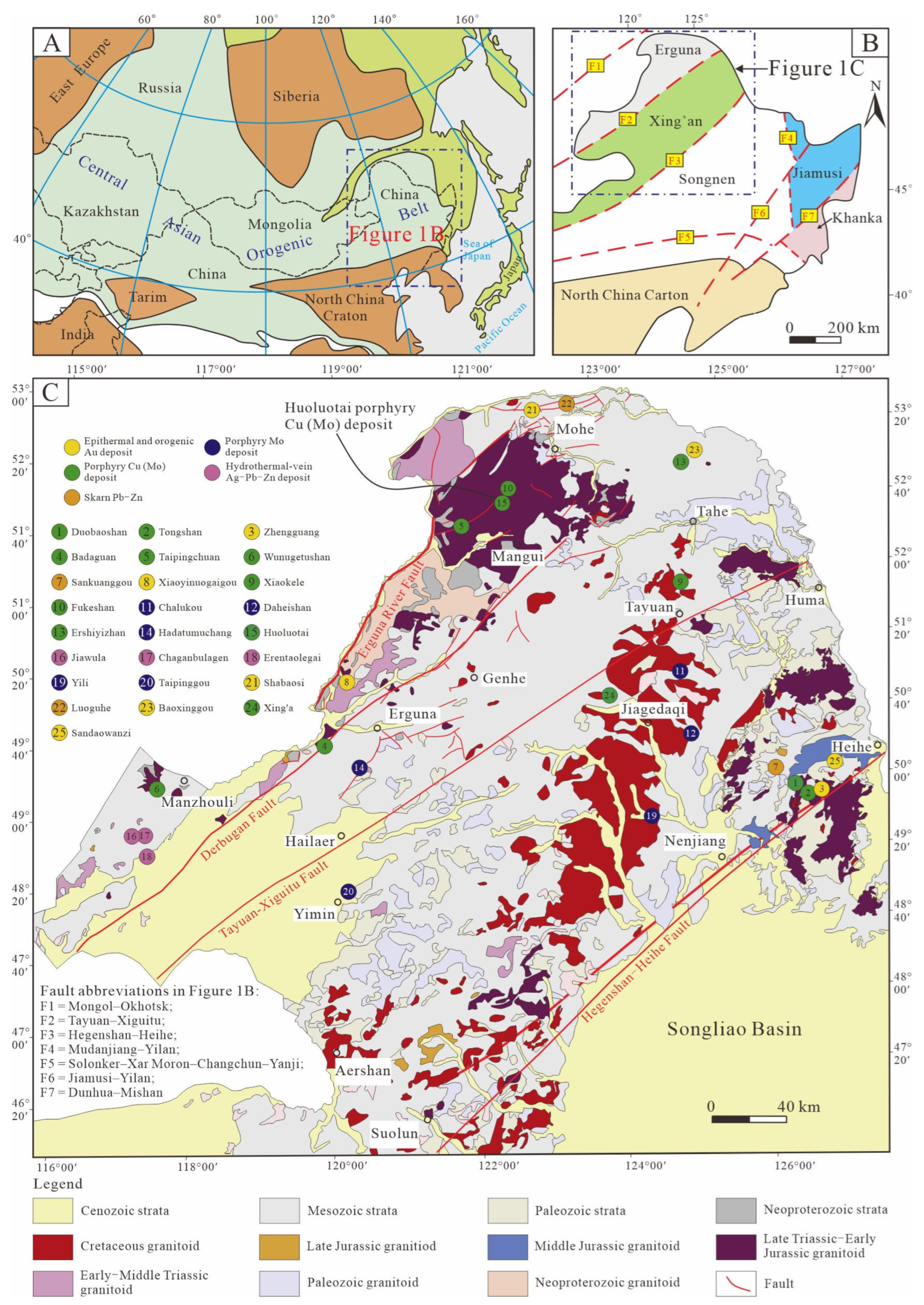
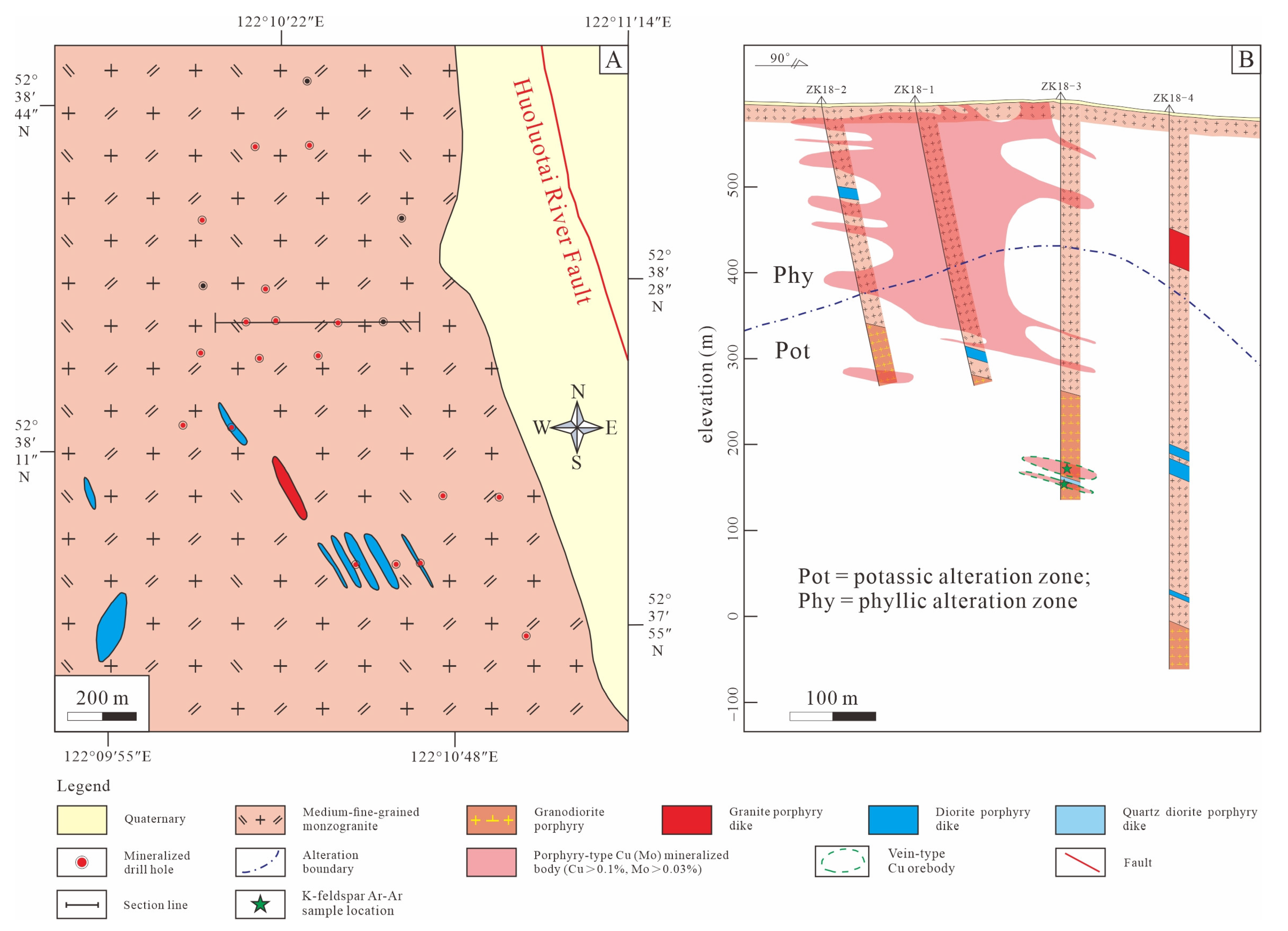
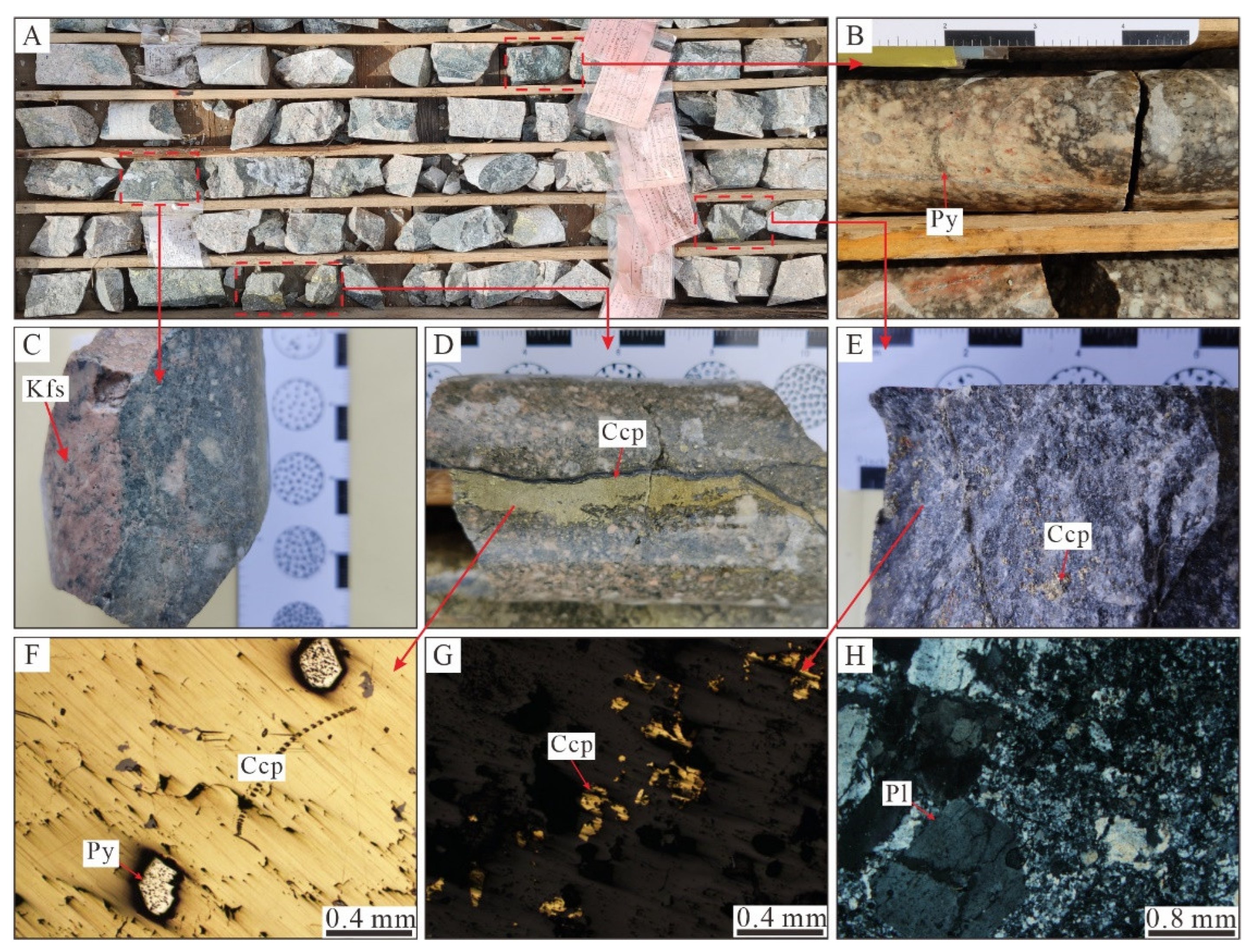
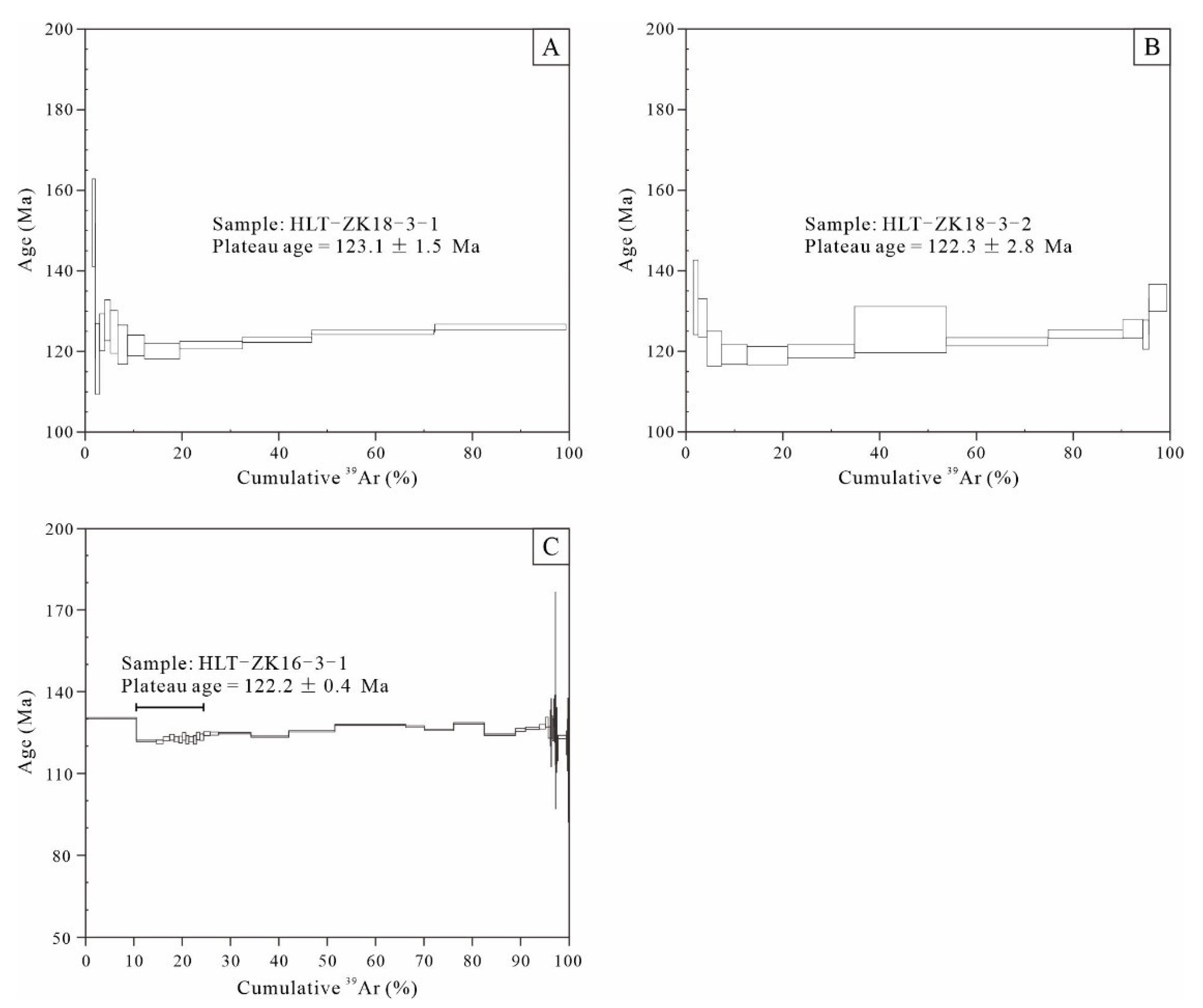
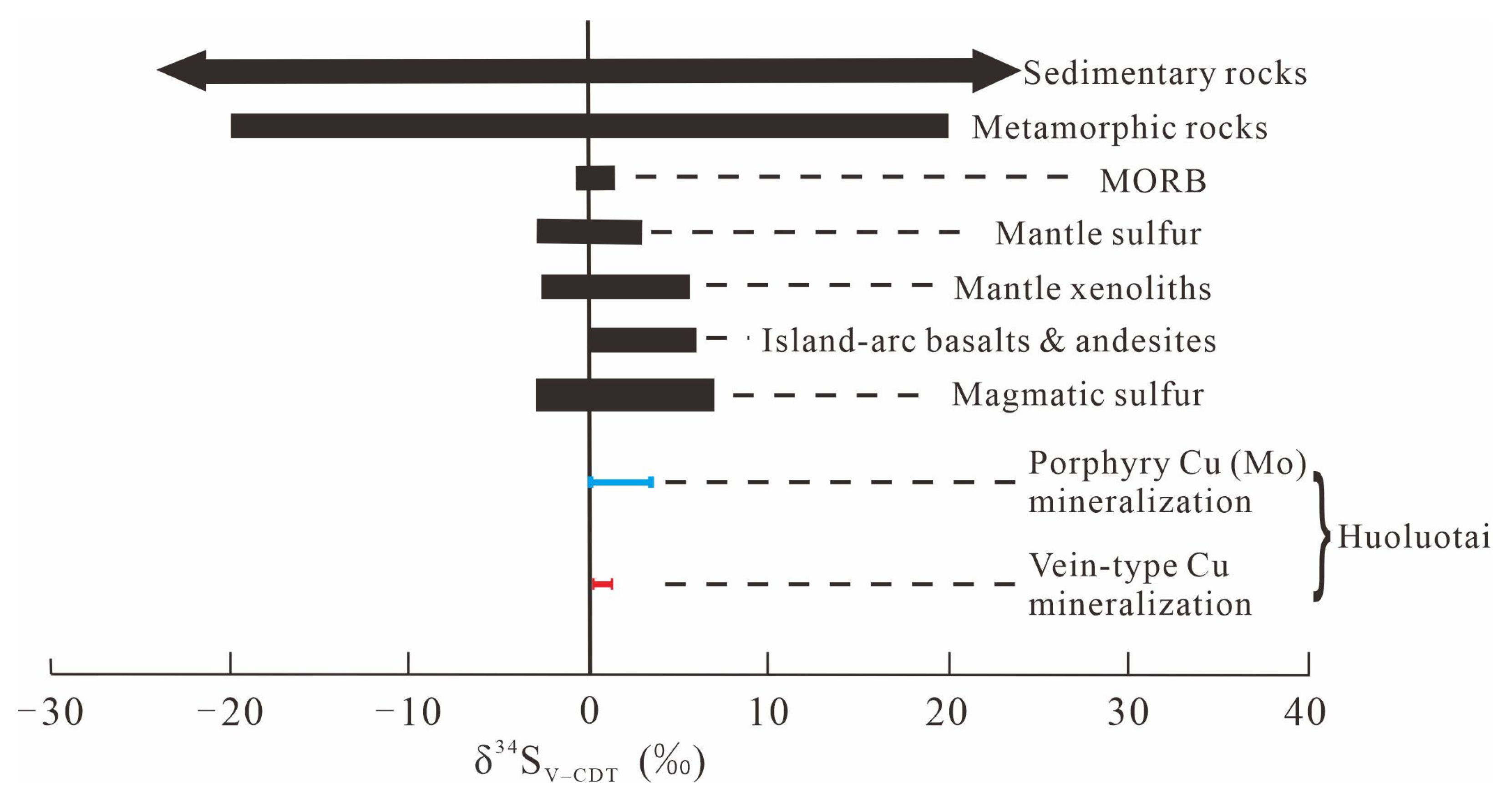
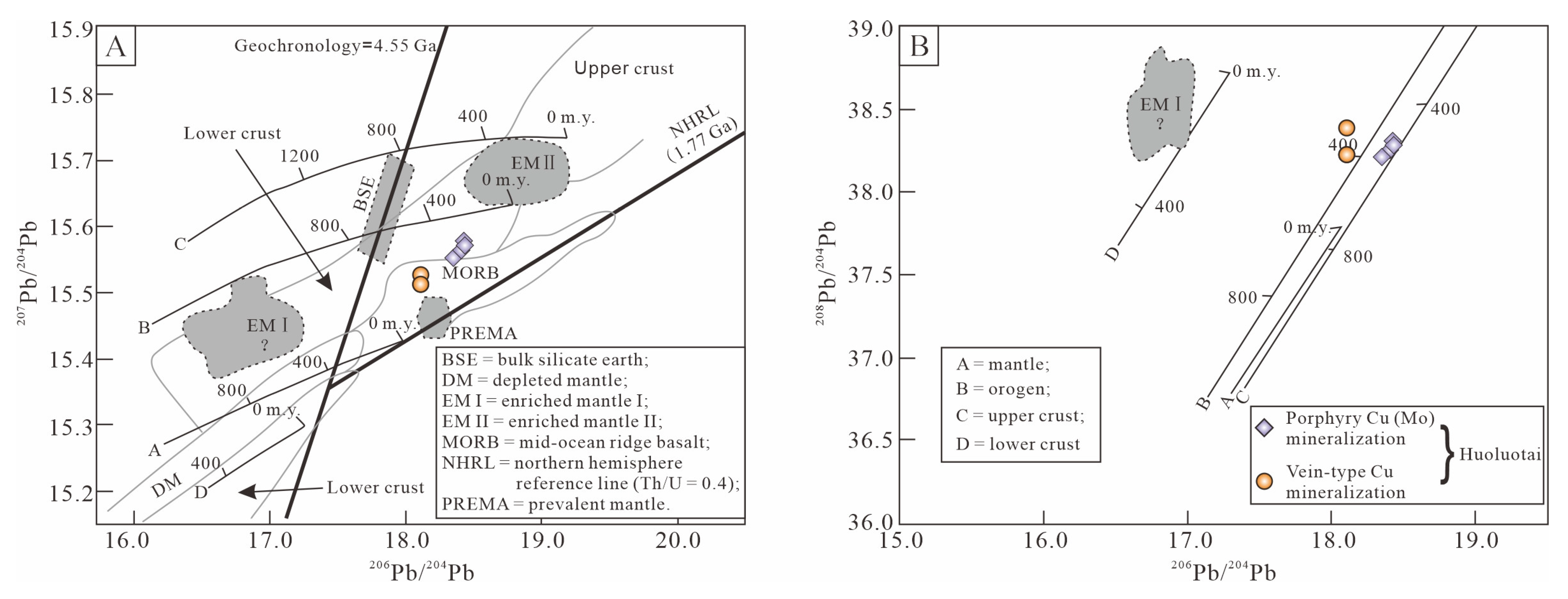
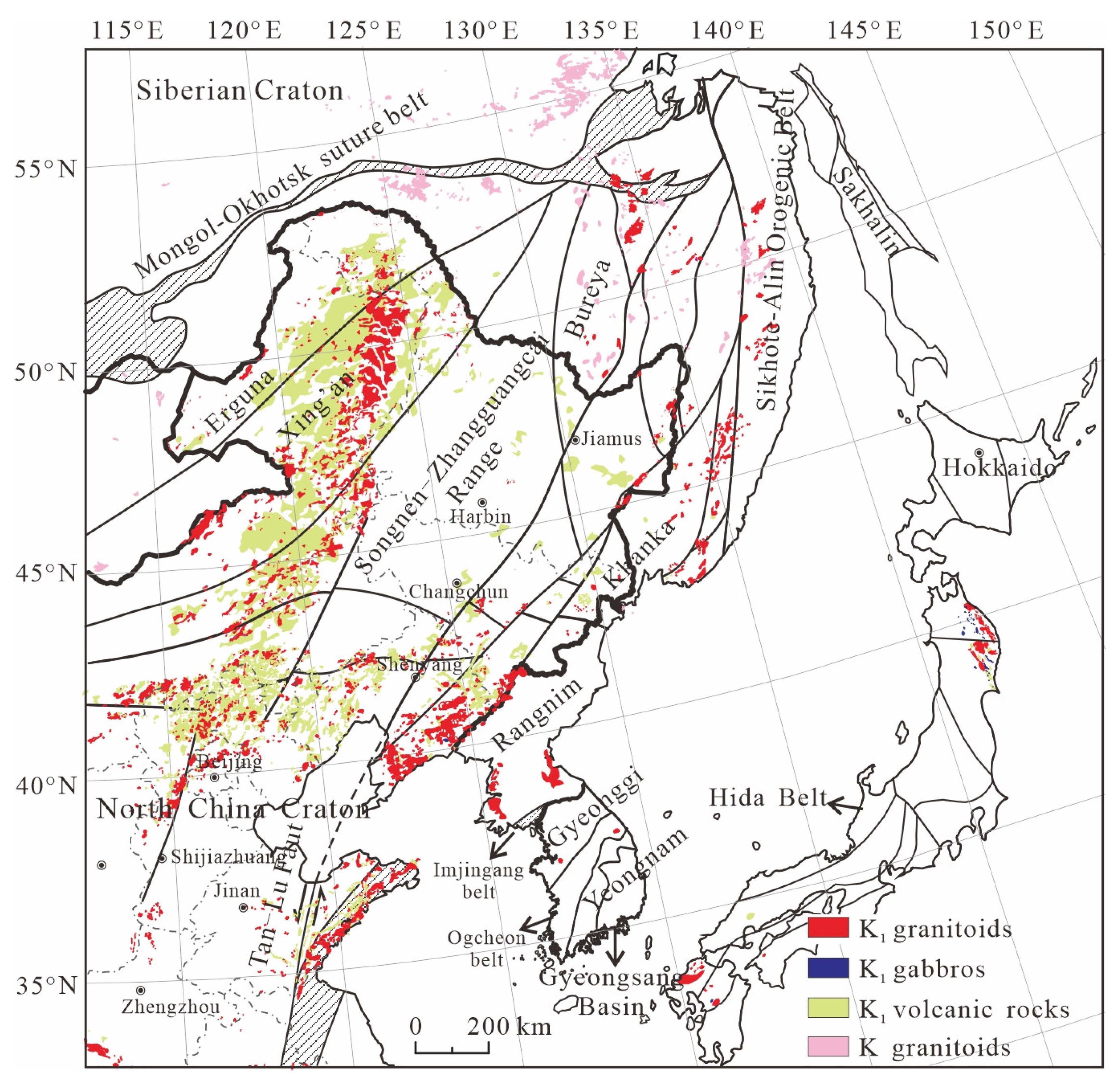
| Sample No. | Mineral | Sample Description | δ34SV–CDT (‰) |
|---|---|---|---|
| HLT-ZK18-3-S1 | Pyrite | Py vein | 1.4 |
| HLT-ZK18-3-S2 | Chalcopyrite | disseminated Ccp | 0.4 |
| HLT-ZK18-3-S3 | Chalcopyrite | massive Ccp | 0.6 |
| HLT-ZK18-3-S4 | Pyrite | Py + Ccp vein | 1.2 |
| Sample No. | Mineral | Sample Description | 206Pb/204Pb | Error | 207Pb/204Pb | Error | 208Pb/204Pb | Error |
|---|---|---|---|---|---|---|---|---|
| HLT-ZK18-3-Pb1 | Pyrite | Py vein | 18.1062 | 0.0003 | 15.5252 | 0.0003 | 38.3889 | 0.0008 |
| HLT-ZK18-3-Pb2 | Chalcopyrite | disseminated Ccp | 18.1058 | 0.0005 | 15.5121 | 0.0004 | 38.2272 | 0.0011 |
| HLT-ZK18-3-Pb3 | Chalcopyrite | massive Ccp | 18.1068 | 0.0005 | 15.5120 | 0.0004 | 38.2265 | 0.0011 |
Disclaimer/Publisher’s Note: The statements, opinions and data contained in all publications are solely those of the individual author(s) and contributor(s) and not of MDPI and/or the editor(s). MDPI and/or the editor(s) disclaim responsibility for any injury to people or property resulting from any ideas, methods, instructions or products referred to in the content. |
© 2024 by the authors. Licensee MDPI, Basel, Switzerland. This article is an open access article distributed under the terms and conditions of the Creative Commons Attribution (CC BY) license (https://creativecommons.org/licenses/by/4.0/).
Share and Cite
Sun, Y.; Yang, Z.; Wang, M.; Xie, C.; Chen, X.; Meng, F. Overprinting Mineralization in the Huoluotai Porphyry Cu (Mo) Deposit, NE China: Evidence from K-Feldspar Ar-Ar Geochronology and S-Pb Isotopes. Minerals 2024, 14, 859. https://doi.org/10.3390/min14090859
Sun Y, Yang Z, Wang M, Xie C, Chen X, Meng F. Overprinting Mineralization in the Huoluotai Porphyry Cu (Mo) Deposit, NE China: Evidence from K-Feldspar Ar-Ar Geochronology and S-Pb Isotopes. Minerals. 2024; 14(9):859. https://doi.org/10.3390/min14090859
Chicago/Turabian StyleSun, Yonggang, Zhongjie Yang, Mingliang Wang, Chengcheng Xie, Xusheng Chen, and Fanbo Meng. 2024. "Overprinting Mineralization in the Huoluotai Porphyry Cu (Mo) Deposit, NE China: Evidence from K-Feldspar Ar-Ar Geochronology and S-Pb Isotopes" Minerals 14, no. 9: 859. https://doi.org/10.3390/min14090859
APA StyleSun, Y., Yang, Z., Wang, M., Xie, C., Chen, X., & Meng, F. (2024). Overprinting Mineralization in the Huoluotai Porphyry Cu (Mo) Deposit, NE China: Evidence from K-Feldspar Ar-Ar Geochronology and S-Pb Isotopes. Minerals, 14(9), 859. https://doi.org/10.3390/min14090859






